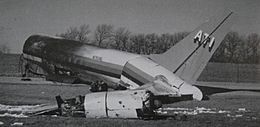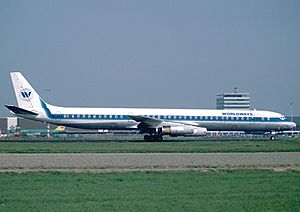Air Transport International Flight 782 facts for kids

Wreckage of N782AL
|
|
| Accident summary | |
|---|---|
| Date | February 16, 1995 |
| Summary | Loss of directional control on takeoff due to pilot error |
| Place | Kansas City International Airport, Kansas City, Missouri, United States 39°18′50.4″N 094°43′51.8″W / 39.314000°N 94.731056°W |
| Passengers | 0 |
| Crew | 3 |
| Fatalities | 3 |
| Survivors | 0 |
| Aircraft type | Douglas DC-8-63F |
| Airline/user | Air Transport International |
| Registration | N782AL |
| Flew from | Kansas City International Airport, Kansas City, Missouri |
| Flying to | Westover Metropolitan Airport, Springfield, Massachusetts |
On February 16, 1995, a cargo plane called Air Transport International Flight 782 had an accident. This Douglas DC-8 aircraft was on a special trip, called a ferry flight, from Kansas City, Missouri, to Springfield, Massachusetts. One of its four engines was not working. During takeoff from Kansas City International Airport, the plane went off the runway and crashed. All three people on board, who were the flight crew, sadly died. Investigators later found that the crew's training was not good enough. They did not fully understand how to take off with only three engines working.
Contents
The Aircraft and Its Crew
The plane in the accident was a Douglas DC-8-63F. Its registration number was N782AL. This aircraft was the 367th DC-8 ever built. Over the years, it had several owners and was used by different airlines.
It started with Canadian Pacific Air Lines. Later, it flew for Flying Tiger Line and Worldways Canada. In 1985, Worldways Canada leased it to Icelandair and Air Algérie. In 1990, the plane was bought by Aerolease Financial Group. They changed it into a cargo plane, also known as a freighter.
After that, it was leased to Burlington Air Express. In 1994, Air Transport International (ATI) started leasing it. At the time of the accident, the plane had flown for a very long time. It had spent 77,096 hours in the air. It had also completed 22,404 take-offs and landings.
Who Was Flying the Plane?
There were three crew members on board Flight 782.
The pilot, called the captain, was 48-year-old Walter Miga, Sr. He had a lot of flying experience. He had flown for 9,711 hours in total. About 4,483 of those hours were on the DC-8 plane. He had worked for ATI since 1994.
The co-pilot, called the first officer, was 38-year-old Mark Ulmer. He was still in training for the DC-8 aircraft. He had not yet received his official license to fly this specific type of plane. He had flown the DC-8 for 171 hours. However, his total flight experience was 4,261 hours.
The flight engineer was 48-year-old Kerry Hardy. He had worked for the United States Air Force before. He had 4,460 hours of flight experience. Only 218 of those hours were on the DC-8. He was also in a training period at ATI.
What Happened During the Flight
On the day of the accident, the plane, N782AL, landed at Kansas City Airport. It had just finished a cargo flight from Denver, Colorado. The crew loaded new cargo onto the plane. It was supposed to fly to Toledo, Ohio.
However, the crew who were supposed to fly it had a problem. They could not start the number one engine, which was on the far left. Maintenance workers checked the engine. They found that a part called the gear ratio had broken. This part could not be fixed at the airport.
So, ATI decided the plane would make a special "ferry flight." This means flying the plane to another airport for repairs. The destination was Westover Metropolitan Airport in Massachusetts. Another ATI DC-8 plane arrived from Germany. The cargo and the original crew were moved to that plane. The crew who later had the accident were assigned to fly N782AL for its repair trip.
Engine Troubles and First Takeoff Attempt
When the accident crew tried to start the engines, they had more problems. The number 4 engine, on the far right, did not start at first. Its ignition circuit breaker was accidentally left open. They closed the breaker and tried again. This time, a worker on the ground saw smoke coming from the engine. The crew quickly shut it down.
They waited for the engine to cool down. Then, they started the number 2 engine. After that, they tried starting the number 4 engine a third time. This time, it started without any issues.
At 8:20 PM local time, Flight 782 began its first attempt to take off. The cockpit voice recorder (CVR) showed that everything seemed normal at first. The first officer called out "hundred knots," meaning the plane reached 100 knots (about 115 miles per hour (185 km/h)). But one second later, the captain said, "Abort." They stopped the takeoff.
The plane left the runway. The air traffic controller asked if they needed help, but the crew said no. The captain told the crew he had trouble keeping the plane straight. He said the nose of the plane "just came up too fast." At 8:21 PM, the crew decided to try taking off again.
Second Takeoff and Crash
At 8:27 PM, Flight 782 started its second takeoff attempt. The plane traveled about 3,220 feet (980 m) down the runway. Then, it started to turn to the left. After another 590 feet (180 m), the plane's nose lifted too early. The tail of the plane scraped the runway for about 820 feet (250 m).
The plane used up about 5,200 feet (1,600 m) of the runway before it finally got into the air. But it only climbed to about 98 feet (30 m). The plane then tilted sharply to the left. It lost speed and control, which is called a stall. Then, it crashed to the ground. The plane slid and broke into pieces. The wreckage stopped after about 7,500 feet (2,300 m). All three crew members died in the crash.
The Investigation Findings
The National Transportation Safety Board (NTSB) investigated the crash of Flight 782. They looked into many things, including the training of the captain, Walter Miga. One training captain had written that Miga "would make a good captain." However, another trainer felt Miga needed more confidence to be a pilot in command.
Another check captain said Miga was good at controlling the plane. But he suggested Miga should only fly domestic flights, not international ones. Despite this, Miga continued to fly international flights. He had also completed training for three-engine ferry flights. He had even flown two such flights as a first officer. However, Flight 782 was his first time flying a three-engine ferry flight as the captain.
The NTSB also looked at First Officer Mark Ulmer's training. He had faced some challenges during his flight tests in 1989, 1992, and 1993. Each time, he went through more training and passed on his second try.
Flight Engineer Kerry Hardy had made a mistake. He entered the wrong minimum control speed for the plane. This speed is important for safe takeoff. He used 107 knots (123 mph) instead of the correct 116 knots (133 mph). He also used the Fahrenheit scale instead of Celsius for a calculation. The captain and first officer did not check these speeds, even though they were supposed to.
The NTSB concluded that the accident happened because the crew did not follow important rules. They decided to continue the takeoff even when the plane was too slow to lift off safely. ATI, the airline, had not given them proper training. Because of this, the crew did not fully understand how to take off with only three engines.
The NTSB also found that the airline did not give the crew enough rest. This could have made the crew tired. However, the NTSB could not say for sure if being tired caused the accident. Finally, the Federal Aviation Administration (FAA), which oversees airlines, did not do a good job of checking ATI's rest rules and overall operations.
See also
 In Spanish: Vuelo 782 de Air Transport International para niños
In Spanish: Vuelo 782 de Air Transport International para niños


